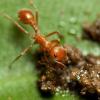Found these Pogonomyrmex queens at a local park. But, as I was researching Pogonomyrmex, I learned some species are fully claustral, while others are only semi claustral! I'm trying to get their specific species, so I know if I need to feed them/give them an outworld right away.
I've got five of them total - Tiny (seems smaller than the others, possibly a different species?), Demeter, Wing (won't settle down, probably infertile), 4 and 5 (no names yet, lol). I think they're all the same, except perhaps Tiny. Demeter and Tiny both laid two to four eggs overnight.
Location: Urban park, Northglenn, Colorado, USA
Date: 6/29/18 and 6/30/18
Elevation: about 5700ft
Time: Between between 12 noon and 3pm
Length: 9mm, except for Tiny, who is about 7mm
Coloration: Moflippin orange. They were practically fluorescent in the sunshine, but they're still very orange looking even indoors. Lots of hairs, very velvety looking. I noticed workers from nearby nests are not as brightly colored, they're more rusty orange or brownish. Note that Tiny, in addition to being smaller, also seems a bit darker in color (it's not just lighting).
Characteristics: Two petiole nodes on waist, two small spikes on the backside of the thorax. I feel like all of them have small looking gasters, which is what initially made me wonder if they're semi-claustral.
Behavior: Very active; They weren't scared of my test tube, but they certainly didn't have time for my nonsense, they were all on a mission. In their test tubes, they all seem kind of... panicked? or... Antsy? LOL They all seem like they want more space, they want to go somewhere, even if they've already laid some eggs. Another reason why I think they might be a semi-claustral species.





















